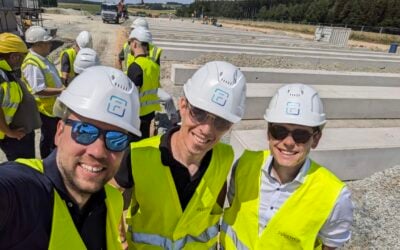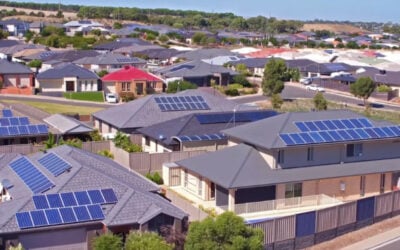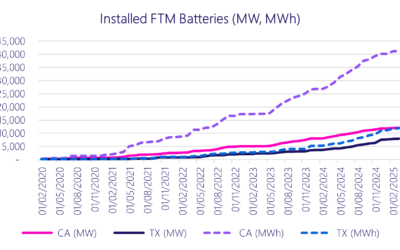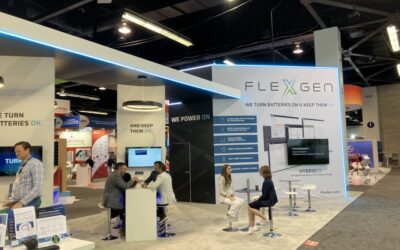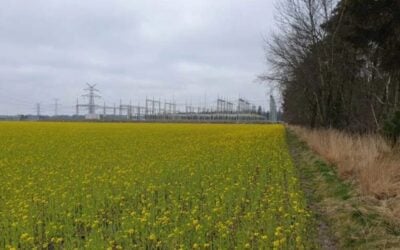
There is “huge potential” for commercial and industrial (C&I) battery systems in Germany’s wholesale trading markets, according to Tesvolt.
Lithium-ion (Li-ion) battery storage system manufacturer Tesvolt has launched a new subsidiary that will sell energy stored in its customers’ systems in the power market.
Enjoy 12 months of exclusive analysis
- Regular insight and analysis of the industry’s biggest developments
- In-depth interviews with the industry’s leading figures
- Annual digital subscription to the PV Tech Power journal
- Discounts on Solar Media’s portfolio of events, in-person and virtual
The subsidiary, Tesvolt Energy, will do this in partnership with energy trading companies enspired, Entrix and The Mobility House, aggregating systems of 100kWh and up to 10MWh into a virtual power plant (VPP) pool.
Tesvolt, which is itself headquartered in Germany, has developed software controls for the battery energy storage system (BESS) units that the company claimed will help minimise wear and tear while optimising revenues its trading partners can earn from them.
The idea is that although the electricity grid requires storage as a buffer to manage volatility added by the integration of renewable energy sources, operators or owners of C&I systems “often have no chance of finding a good trader who will trade their storage capacity on the utility grid,” due to the market’s focus being more typically on large-scale utility storage systems, Tesvolt co-founder and CEO Daniel Hannemann said in a statement last month as Tesvolt Energy launched.
Sebastian Kratz, who has been appointed CEO of Tesvolt Energy, told Energy-Storage.news this morning that “the cost of smaller battery storage systems was too high and the revenue opportunities too low,” in the past.
“Energy traders were also not interested in individual smaller systems,” Kratz said.
“Our new concept of a C&I commercial storage system with high cycle stability—even more guaranteed full cycles than utility-scale storage systems—with the same market access as large-scale projects by bundling the small BESS into a virtual power plant is changing that.”
Parent company Tesvolt makes Li-ion energy storage systems using Samsung SDI battery cells. The manufacturer and system integrator broke ground last April on a BESS factory with 4GWh annual production capacity next door to its existing production plant in Lutherstadt Wittenberg, Saxony-Anhalt, Germany.
A couple of months later, it received its biggest single project order to date for a 65MWh utility-scale system in the state of Rhineland-Palatinate, also Germany, although Tesvolt project manager Philipp Schreiber told Energy-Storage.news at the time that C&I will “always be the core” of the company’s business.
Energy trading ‘brings much-needed flexibility to the grid’
While the C&I market has therefore been relatively slow to take off, Kratz said that based on analysts’ forecasting, there are around 535MWh of new installations expected in the segment in Germany this year. While growth will be gradual, it will be supported by Germany’s C&I solar PV market which is “already well-established,” Kratz said.
“We see huge potential for the energy trading business case: it brings much-needed flexibility to the grid, and Tesvolt Energy’s business model enables high returns and low risk.”
The three trading and optimisation partners will be put into competition with each other, which Tesvolt Energy hopes will “create good market conditions for smaller BESS projects.”
According to the Tesvolt Energy CEO, smaller projects also have an advantage in that they are subjected to fewer restrictions than their utility-scale counterparts and can obtain permits for construction and connection to the grid more quickly.
Germany has been identified as one of Europe’s ‘hottest’ markets for energy storage, with a pipeline of around 230GWh of utility-scale BESS currently in the grid connection queue.
This is largely due to the depth and liquidity of its wholesale power markets, according to sources Energy-Storage.news has recently spoken to, including Roberto Jimenez, executive director of BESS developer-investor BW ESS and Wood Mackenzie energy storage analyst Anna Darmani (Premium access).
Several new energy storage revenue benchmarking indexes have launched in the past few months from traders, including Tesvolt Energy partner enspired, highlighting the scale of current opportunities in Germany.
Tesvolt hopes that its new subsidiary will be able to capture some of that value for smaller C&I systems through their combination into a VPP. At the time of Tesvolt Energy’s launch in early February, the company claimed it already had a 100MWh pipeline of assets waiting to go into the VPP pool.
Meanwhile, Kratz explained that the three traders will be put into competition through Tesvolt Energy’s in-house Trader Benchmark platform.
“The energy trader whose trades generate the highest revenues with the least intensive operation of the storage systems gets to manage the most battery systems in our pool,” he said.
“This means that everyone benefits—the traders, us and, most importantly, our customers who are making the investment.”
Additionally, while wholesale trading will be the main revenue generator for systems in Tesvolt Energy’s VPP, the parent company also plans to prequalify its Forton outdoor storage system for participation in the automatic Frequency Restoration Reserve (aFRR) ancillary service.
Tesvolt Energy has plans to expand into Switzerland and Austria, although “not in the short-term,” the CEO said, noting that the company is presently “fully focused on the German market, which has huge potential.”

